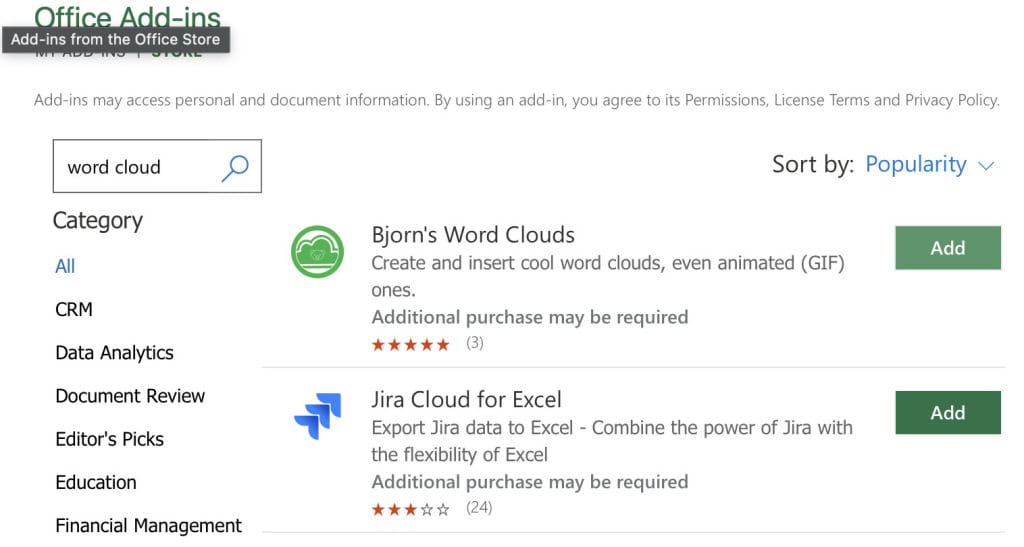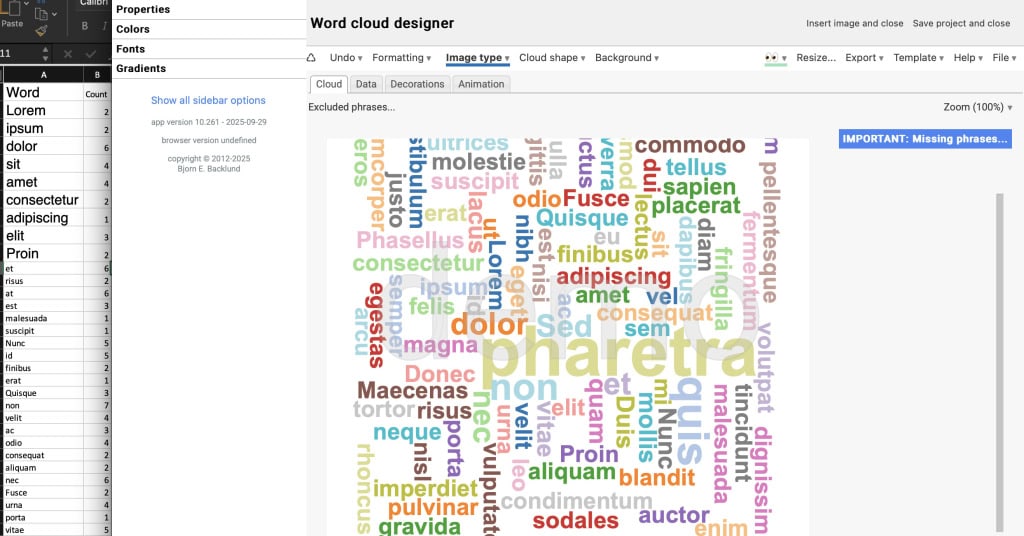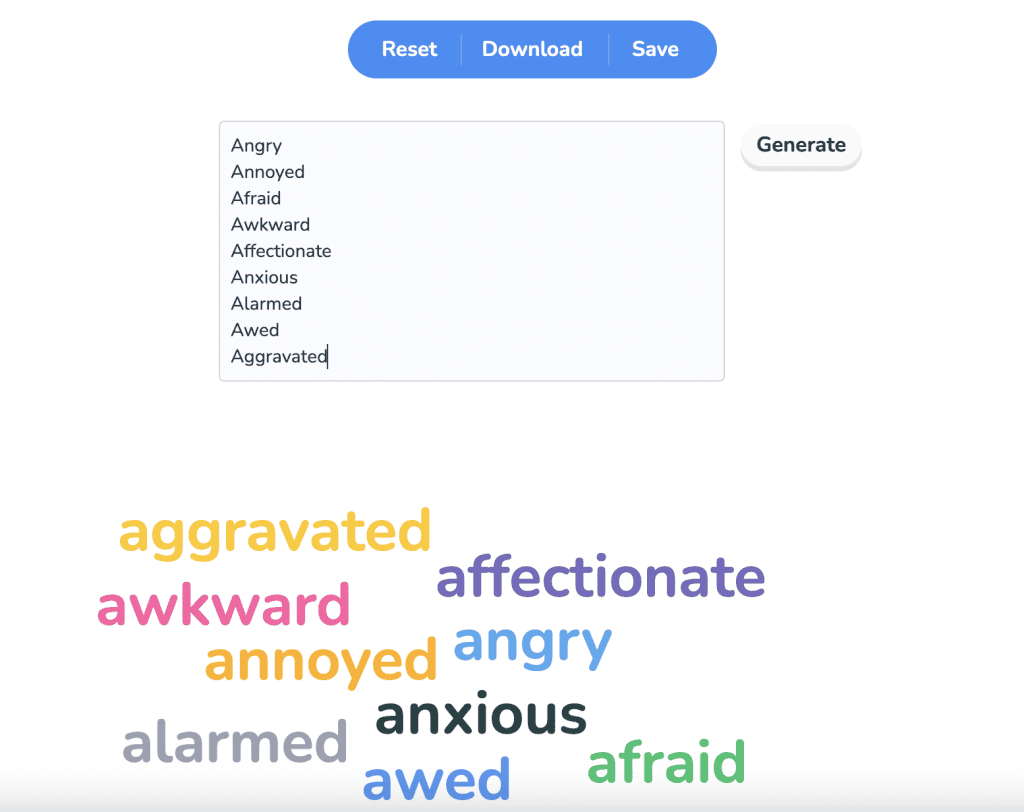ఎక్సెల్లో అంతర్నిర్మిత వర్డ్ క్లౌడ్ ఫీచర్ లేకపోయినా, మీరు సృష్టించవచ్చు ఎక్సెల్ వర్డ్ మేఘాలు క్రింద ఉన్న 3 పద్ధతుల్లో దేనినైనా ఉపయోగించి సులభంగా:
విధానం 1: ఎక్సెల్ యాడ్-ఇన్ని ఉపయోగించండి
అత్యంత సమగ్రమైన పద్ధతి ఏమిటంటే యాడ్-ఇన్ని ఉపయోగించడం, ఇది మీ ఎక్సెల్ స్ప్రెడ్షీట్లోనే నేరుగా వర్డ్ క్లౌడ్ను సృష్టించడానికి మిమ్మల్ని అనుమతిస్తుంది. జనాదరణ పొందిన మరియు ఉచిత ఎంపిక బ్జోర్న్ వర్డ్ క్లౌడ్. మీరు యాడ్-ఇన్ లైబ్రరీలో ఇతర వర్డ్ క్లౌడ్ సాధనాల కోసం శోధించవచ్చు.
దశ 1: మీ డేటాను సిద్ధం చేయండి
- మీరు విశ్లేషించాలనుకుంటున్న అన్ని వచనాలను ఒకే నిలువు వరుసలో ఉంచండి. ప్రతి సెల్ ఒకటి లేదా బహుళ పదాలను కలిగి ఉండవచ్చు.
దశ 2: "బ్జోర్న్ వర్డ్ క్లౌడ్" యాడ్-ఇన్ను ఇన్స్టాల్ చేయండి
- వెళ్ళండి చొప్పించు రిబ్బన్పై టాబ్.
- నొక్కండి యాడ్-ఇన్లను పొందండి.
- ఆఫీస్ యాడ్-ఇన్స్ స్టోర్లో, "బ్జోర్న్ వర్డ్ క్లౌడ్" కోసం శోధించండి.
- క్లిక్ చేర్చు ప్రో వర్డ్ క్లౌడ్ యాడ్-ఇన్ పక్కన ఉన్న బటన్.

దశ 3: వర్డ్ క్లౌడ్ను రూపొందించండి
- వెళ్ళండి చొప్పించు టాబ్ మరియు క్లిక్ చేయండి నా యాడ్-ఇన్లు.
- ఎంచుకోండి బ్జోర్న్ వర్డ్ క్లౌడ్ మీ స్క్రీన్ కుడి వైపున దాని ప్యానెల్ను తెరవడానికి.
- యాడ్-ఇన్ మీరు ఎంచుకున్న టెక్స్ట్ పరిధిని స్వయంచాలకంగా గుర్తిస్తుంది. క్లిక్ చేయండి వర్డ్ క్లౌడ్ను సృష్టించండి బటన్.

దశ 4: అనుకూలీకరించండి మరియు సేవ్ చేయండి
- మీ పదాల ఫాంట్, రంగులు, లేఅవుట్ (క్షితిజ సమాంతర, నిలువు, మొదలైనవి) మరియు కేస్ను అనుకూలీకరించడానికి యాడ్-ఇన్ అనేక ఎంపికలను అందిస్తుంది.
- మీరు ప్రదర్శించబడే పదాల సంఖ్యను కూడా సర్దుబాటు చేయవచ్చు మరియు సాధారణ "స్టాప్ వర్డ్స్" ('the', 'and', 'a' వంటివి) ఫిల్టర్ చేయవచ్చు.
- ప్యానెల్లో క్లౌడ్ అనే పదం కనిపిస్తుంది. మీరు దానిని SVG, GIF లేదా వెబ్పేజీగా ఎగుమతి చేయవచ్చు.
విధానం 2: ఉచిత ఆన్లైన్ వర్డ్ క్లౌడ్ జనరేటర్ని ఉపయోగించండి
మీరు యాడ్-ఇన్ను ఇన్స్టాల్ చేయకూడదనుకుంటే, మీరు ఉచిత ఆన్లైన్ సాధనాన్ని ఉపయోగించవచ్చు. ఈ పద్ధతి తరచుగా మరింత అధునాతన అనుకూలీకరణ ఎంపికలను అందిస్తుంది.
దశ 1: ఎక్సెల్లో మీ డేటాను సిద్ధం చేసి కాపీ చేయండి
- మీ అన్ని వచనాలను ఒకే నిలువు వరుసలో నిర్వహించండి.
- మొత్తం కాలమ్ను హైలైట్ చేసి, దానిని మీ క్లిప్బోర్డ్కు కాపీ చేయండి (Ctrl+C).
దశ 2: ఆన్లైన్ సాధనాన్ని ఉపయోగించండి
- ఉచిత వర్డ్ క్లౌడ్ జనరేటర్ వెబ్సైట్కి నావిగేట్ చేయండి, ఉదాహరణకు AhaSlides వర్డ్ క్లౌడ్ జనరేటర్, లేదా https://www.google.com/search?q=FreeWordCloud.com.
- "దిగుమతి" లేదా "వచనాన్ని అతికించు" ఎంపిక కోసం చూడండి.
- Excel నుండి మీరు కాపీ చేసిన టెక్స్ట్ను అందించిన టెక్స్ట్ బాక్స్లో అతికించండి.

దశ 3: రూపొందించండి, అనుకూలీకరించండి మరియు డౌన్లోడ్ చేయండి
- వర్డ్ క్లౌడ్ను సృష్టించడానికి "జనరేట్" లేదా "విజువలైజ్" బటన్ను క్లిక్ చేయండి.
- ఫాంట్లు, ఆకారాలు, రంగులు మరియు పద ధోరణిని అనుకూలీకరించడానికి వెబ్సైట్ సాధనాలను ఉపయోగించండి.
- మీరు సంతృప్తి చెందిన తర్వాత, క్లౌడ్ అనే పదాన్ని చిత్రంగా డౌన్లోడ్ చేసుకోండి (సాధారణంగా PNG లేదా JPG).
విధానం 3: పవర్ BI ని ఉపయోగించండి
మీ డెస్క్టాప్లో పవర్ BI సిద్ధంగా ఉంటే, మీరు పెద్ద మొత్తంలో పదాలను ప్రాసెస్ చేయాల్సి వచ్చినప్పుడు ఎక్సెల్ వర్డ్ క్లౌడ్లను రూపొందించడానికి ఇది మంచి కానీ మరింత అధునాతన మార్గం కావచ్చు.
దశ 1: ఎక్సెల్లో మీ డేటాను సిద్ధం చేయండి
ముందుగా, మీరు మీ టెక్స్ట్ డేటాను ఎక్సెల్ షీట్లో సరిగ్గా నిర్వహించాలి. ఆదర్శవంతమైన ఫార్మాట్ అనేది ప్రతి సెల్లో మీరు విశ్లేషించాలనుకుంటున్న పదాలు లేదా పదబంధాలు ఉండే ఒకే కాలమ్.
- ఒక నిలువు వరుసను సృష్టించండి: మీ వచనం మొత్తాన్ని ఒకే నిలువు వరుసలో ఉంచండి (ఉదా., నిలువు వరుస A).
- పట్టికగా ఫార్మాట్ చేయండి: మీ డేటాను ఎంచుకుని నొక్కండి Ctrl + T. ఇది దీనిని అధికారిక ఎక్సెల్ టేబుల్గా ఫార్మాట్ చేస్తుంది, దీనిని పవర్ BI మరింత సులభంగా చదువుతుంది. టేబుల్కు స్పష్టమైన పేరు ఇవ్వండి (ఉదా., "వర్డ్డేటా").
- సేవ్ మీ ఎక్సెల్ ఫైల్.
దశ 2: మీ ఎక్సెల్ ఫైల్ను పవర్ BI లోకి దిగుమతి చేసుకోండి
తరువాత, పవర్ BI డెస్క్టాప్ను తెరవండి (ఇది ఉచిత డౌన్లోడ్ మైక్రోసాఫ్ట్) మీ ఎక్సెల్ ఫైల్కి కనెక్ట్ చేయడానికి.
- పవర్ BI తెరవండి.
- న హోమ్ టాబ్, క్లిక్ చేయండి డేటాను పొందండి మరియు ఎంచుకోండి ఎక్సెల్ వర్క్బుక్.
- మీరు ఇప్పుడే సేవ్ చేసిన ఎక్సెల్ ఫైల్ను కనుగొని తెరవండి.
- లో Navigator కనిపించే విండోలో, మీ టేబుల్ పేరు పక్కన ఉన్న పెట్టెను ఎంచుకోండి ("వర్డ్డేటా").
- క్లిక్ చేయండి లోడ్. మీ డేటా ఇప్పుడు ఇందులో కనిపిస్తుంది సమాచారం పవర్ BI విండో యొక్క కుడి వైపున ఉన్న పేన్.
దశ 3: వర్డ్ క్లౌడ్ను సృష్టించండి మరియు కాన్ఫిగర్ చేయండి
ఇప్పుడు మీరు వాస్తవ దృశ్యాన్ని నిర్మించవచ్చు.
- దృశ్యమానతను జోడించండి: లో విజువలైజేషన్స్ పేన్లో, కనుగొని దానిపై క్లిక్ చేయండి వర్డ్ క్లౌడ్ చిహ్నం. మీ రిపోర్ట్ కాన్వాస్పై ఖాళీ టెంప్లేట్ కనిపిస్తుంది.
- మీ డేటాను జోడించండి: నుండి సమాచారం పేన్, మీ టెక్స్ట్ కాలమ్ను లాగి, దానిని వర్గం విజువలైజేషన్ పేన్లో ఫీల్డ్.
- రూపొందించు: పవర్ BI ప్రతి పదం యొక్క ఫ్రీక్వెన్సీని స్వయంచాలకంగా లెక్కించి, పదం క్లౌడ్ను ఉత్పత్తి చేస్తుంది. ఒక పదం ఎంత తరచుగా వస్తుంటే, అది అంత పెద్దదిగా కనిపిస్తుంది.
చిట్కాలు
- ముందుగా మీ డేటాను క్లీన్ చేయండి: స్పష్టమైన ఫలితాల కోసం స్టాప్ పదాలు (“మరియు”, “ది”, “is” వంటివి), విరామ చిహ్నాలు మరియు నకిలీలను తొలగించండి.
- మీ వచనం బహుళ సెల్లలో ఉంటే, ఇలాంటి సూత్రాలను ఉపయోగించండి
=TEXTJOIN(" ",TRUE,A1:A50)ప్రతిదీ ఒకే కణంలోకి కలపడానికి. - వర్డ్ క్లౌడ్లు విజువలైజేషన్కు గొప్పవి, కానీ ఖచ్చితమైన ఫ్రీక్వెన్సీ గణనలను చూపించవద్దు—లోతైన విశ్లేషణ కోసం వాటిని పివోట్ టేబుల్ లేదా బార్ చార్ట్తో జత చేయడాన్ని పరిగణించండి.





